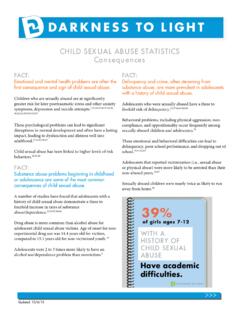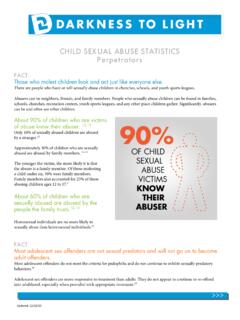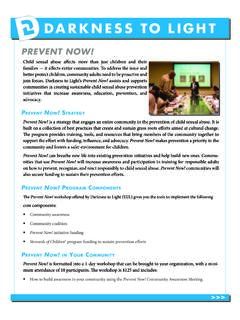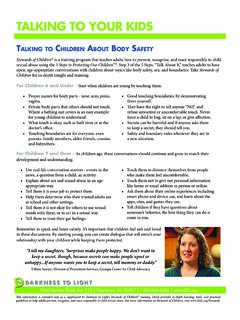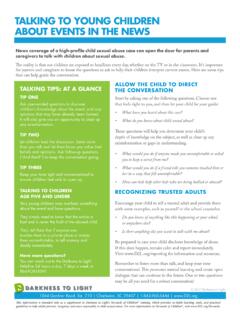Transcription of Child Sexual Abuse Disclosure: What Practitioners Need to …
1 February, 2016 Author: Catherine Townsend, Grants, Research & National Strategy Manager, Darkness to Light For more information, please contact: Darkness to Light 1064 Gardner Road, Suite 210 Charleston, SC 29407 843-513-1616 The information contained in this paper represents the current view of Darkness to Light as of the date of publication. This paper is for informational purposes only. Darkness to Light makes no warranties, expressed, implied or statutory as to the information in this document. Suggested Citation: Townsend, C. (2016). Child Sexual Abuse disclosure: What Practitioners need to know. Charleston, , Darkness to Light. Retrieved from Copyright 2016 Darkness to Light.
2 All rights reserved. Special thanks to the National Children s Advocacy Center for the use of Disclosure of Child Sexual Abuse : A bibliography. Child Sexual Abuse Disclosure: What Practitioners Need to Know THIS PAGE INTENTIONALLY LEFT BLANK TABLE OF CONTENTS SECTION 1: Practitioners Need Information on the Disclosure of Child Sexual Abuse The role of disclosure in framing the issue 1 Low disclosure rates are a complicating factor 1 Informing practice 2 SECTION 2: The Facts About Disclosing Child Sexual Abuse Definitions 2 Do children delay or, in some cases, never disclose their Child Sexual Abuse experiences? 2 How do researchers measure disclosure? 3 What is the rate of disclosure?
3 3 Are rates of disclosure going up in the wake of the media attention around the issue of Child Sexual Abuse ? 5 Who do children tell? 6 What are the some of the established consequences of non-disclosure? 6 Why do so many children choose not to tell? 7 What factors encourage a Child to disclose Abuse ? 9 Why do children recant or have inconsistencies in their stories? 10 How do children disclose Abuse ? 10 Does age affect disclosure? 11 Does gender affect disclosure? 11 SECTION 3: Research Can Inform Practice Parenting practices 12 Professional practices 12 Peer-to-peer educational practices 13 Treatment practice 13 APPENDIX Is Child Self-Report Prevalence and Disclosure Research Methodology Valid?
4 The question 14 Evidence 14 Discussion 15 REFERENCES 16 THIS PAGE INTENTIONALLY LEFT BLANK Child Sexual Abuse Disclosure: What Practitioners Need to Know February, 2016 SECTION 1: Practitioners Need Information on Child Sexual Abuse Disclosure The role of disclosure in framing the issue of Child Sexual Abuse Research shows that many children do not disclose Sexual Abuse immediately after the Abuse occurs. In fact, many children do not disclose the Abuse for years, if they disclose at all. Many adult survivors of Child Sexual Abuse have never disclosed their Abuse to anyone. Low disclosure rates are a defining factor in the issue of Child Sexual Abuse .
5 Low disclosure rates are a significant part of the problem that Practitioners face when working to prevent or intervene in Child Sexual Abuse . Low disclosure rates are a complicating factor. There are a number of ways that low disclosure rates complicate the problem of Child Sexual Abuse . Low disclosure rates skew the number of reports and confirmed cases of Child Sexual Abuse , minimizing the problem of Child Sexual Abuse in the public s eyes. Low disclosure rates are a variable that makes it impossible for researchers and Practitioners to determine whether rates of Abuse are increasing or decreasing. If disclosure rates increase, it appears that Child Sexual Abuse rates are increasing, when the opposite may be true.
6 Child Sexual Abuse prevention programs may be effective, but if a program influences disclosure, the data will not reflect that fact. If a program provides caregivers with the tools they need to better elicit disclosure, the additional reports of Abuse that they make can make it appear that Child Sexual Abuse rates have increased. Low disclosure rates mean that those working to intervene in Child Sexual Abuse are not able to reach the entire population of abused children. Many children suffer in silence, without access to the services they need to mitigate the long-term consequences of Abuse . 1 Delayed disclosure of Child Sexual Abuse affects those involved in the criminal justice and legal system.
7 Without education, juries often do not understand why a victim delays coming forward with an accusation of Abuse . While one might expect that the legal system would be more sympathetic to children s difficulties in making disclosures, it may also be the case that the belief is if the Child was really sexually abused, why would they not tell? (Summit, 1983). Many states have statutes of limitations that prevent a victim who has delayed disclosure from bringing an abuser to justice. Informing Practice For Practitioners working to prevent or intervene in Abuse , it is essential to have a thorough understanding of the factors that affect disclosure, including the conditions that promote disclosure.
8 This should inform intervention and prevention practice and guide the development of resources and resource materials. Practices that increase victim disclosures or enable caregivers and bystanders to promote disclosures will not only increase immediate intervention, but will also prevent ongoing Abuse . SECTION 2: The Facts About Disclosing Child Sexual Abuse Although Child Sexual Abuse is notoriously difficult to study, a large body of information about its disclosure has been developed since the late 1980 s. Definitions For the sake of clarity in this discussion, disclosing Abuse will refer to communicating an Abuse experience to friends, family or the authorities.
9 Divulging Abuse will refer to communicating an Abuse experience to researchers. Do children delay or, in some cases, never disclose their Child Sexual Abuse experiences? There is overwhelming evidence that most Child victims delay or never disclose Child Sexual Abuse to friends, family or the authorities (Bottoms, et al., 2007; London, et al., 2005: London, et. al, 2008). Even when there is corroborative evidence that Abuse has occurred medical evidence (Lyon, 2007), or confessions from the abuser or videotaped evidence/witness reports (Sjoberg and Lindblad, 2002), up to 43% of children are not willing to disclose the Abuse . 2 How do researchers measure disclosure?
10 Evidence of non- or delayed disclosure comes from retrospective studies of adult and older adolescent individuals who divulge Abuse to researchers, even if they have never disclosed Abuse to friends, family or the authorities. Researchers measure disclosure by asking self-identified Child or adult victims of Child Sexual Abuse whether they have previously told friends, family or the authorities about their Abuse experience(s). The disclosure rate is the ratio of those victims who have previously disclosed to those have not. Disclosure is typically categorized by time (immediately, within one month, less than five years, and so on). There is no standard for time period categories, making it very difficult to compare studies or determine a valid rate.


